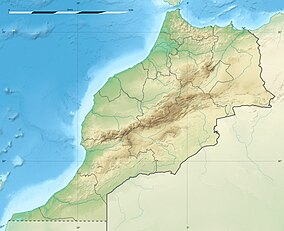Haut Atlas Oriental National Park
| Haut Atlas Oriental National Park | |
|---|---|
| Location | Morocco |
| Coordinates | 32°15′N 5°25′W / 32.250°N 5.417°W |
| Area | 490 km² |
| Official name | Lacs Isly-Tislite |
| Designated | 15 January 2005 |
| Reference no. | 1480[1] |
Haut Atlas Oriental National Park (French: Parc National du Haut Atlas Oriental) is located in Morocco. It covers 49,000 hectares (120,000 acres) in and near the eastern High Atlas mountains.[2] Parts of the park have been designated as a protected Ramsar site since 2005.[1] The park was established to preserve cultural values along with its natural ones.[3]
Geography
This site covers 55,252 ha of the High Atlas between Midelt and Er Rachidia. The base rock consists of limestone with some igneous intrusions. The site ranges in altitude from 1,645 m in the bed of the Oued Arheddou to 3,102 m at the summit of Jbel Tanrhourt. At its western end it includes the twin lakes of Isli and Tislit, near Imilchil. The northern slopes enjoy an annual precipitation of 400–600 mm, and are consequently well-wooded, while the southern slopes are drier, receiving only 200–300 mm, and are more open. Winter snows are abundant and long-lasting at the higher elevations.
Flora and fauna
On the northern side, woody vegetation consists of dense cedar (Cedrus atlantica) and pine (Pinus pinaster maghrebiana) forests, oak (Quercus rotundifolia) woodland, open Juniperus thurifera woodland and, at lower altitudes, some Pinus halepensis. The mountain summits and high plateaus support xerophytic steppe vegetation, and there is some grassland in wetter areas. On the southern slopes cedar woodland is disappearing, but sparse oak and pine woodland persists. Steppe vegetation is predominant, dominated by Stipa tenacissima at lower altitudes.
The park has been designated an Important Bird Area (IBA) by BirdLife International because it supports significant populations of Barbary partridges, Levaillant's woodpeckers, subalpine, spectacled and Tristram's warblers, Moussier's redstarts, and black-eared and black wheatears. Notable mammals include Barbary sheep, Cuvier's gazelles and Barbary macaques. Leopards were once present but, with no confirmed records since 1993, may be locally extinct.[4]
Cultural significance
Haut Atlas Oriental National Park is not only important for its biodiversity but also for its cultural value. The park lies within a region traditionally inhabited by the Berber people, whose communities rely on the land for agriculture, grazing, and other forms of subsistence. The area is particularly famous for the Berber Marriage Festival held in the nearby village of Imilchil, an event that draws thousands of visitors annually.[5]
Tourism and ecotourism
Ecotourism is a growing part of the park's appeal, with visitors drawn to its hiking trails, scenic landscapes, and opportunities to observe wildlife. The park's remote location also offers a more secluded experience compared to more frequented areas of Morocco. Local Berber guides often lead trekking tours through the park, providing visitors with insights into the region's natural and cultural heritage.[6]
Controversy and protests
Despite its ecological and cultural significance, Haut Atlas Oriental National Park has been a subject of controversy.[7] On 17 August 2024, local Berber communities protested against the restrictions imposed by the park’s conservation policies.[8] Many of these communities rely on traditional farming, herding, and resource use, which have been severely limited under the park's regulations. These protests highlight a broader issue of conservation efforts clashing with the rights of indigenous populations who have lived in these areas for generations.
Footnotes
- ^ a b "Lacs Isly-Tislite". Ramsar Sites Information Service. Retrieved 11 September 2018.
- ^ "Communication, Education and Public Awareness in Protected Areas - West Asia and North Africa" (PDF). International Union for Conservation of Nature. Archived from the original (PDF) on 2012-04-20. Retrieved 2011-11-15.
- ^ "Parc National du Haut Atlas Oriental" (in French). Haut Commissariat aux Eaux et Forêts et à la Lutte Contre la Désertification. Archived from the original on 2012-04-25. Retrieved 2011-11-15.
- ^ "Parc National du Haut Atlas Oriental". BirdLife Data Zone. BirdLife International. 2024. Retrieved 2024-10-21.
- ^ "Haut Atlas Oriental National Park". wildsafariguide. Retrieved 5 September 2024.
- ^ "Haut Atlas Oriental National Park". wildsafariguide. Retrieved 5 September 2024.
- ^ David Goeury. "Le parc national contre la démocratie ? Du conflit local à la revendication nationale, le cas du Parc National du Haut-Atlas Oriental (Maroc)".
- ^ Bijiguen, Rachid. "The protesters reject the establishment of the "Atlas Park"". Hespress. Retrieved 5 September 2024.
References
- Parc National du Haut Atlas Oriental. Birdlife International. Accessed 2011-11-15.

